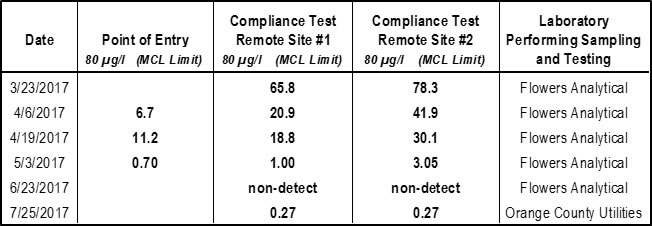Pluris is pleased to present this August update on the Florida Department of Environmental Protection (“FDEP”) approved TTHM Pilot Study to evaluate chlorine dioxide to replace chlorine for disinfection of drinking water in Wedgefield.
In the most recent June 23, 2017 analytical laboratory testing by Flowers Analytical Laboratories, a Florida state certified laboratory, TTHM was undetected in samples taken at the FDEP established compliance test locations in Wedgefield. TTHM values had been declining throughout the Pilot Study to determine the appropriate chlorine dioxide dosage rate.
Unannounced to Pluris, on July 25, 2017 the FDEP scheduled the Orange County Utilities Central Laboratory to conduct sampling and analytical testing for TTHM at the compliance test locations. The Orange County Utilities Central Laboratory test results were 0.27 µg/l and 0.27 µg/l, respectively and by the Orange County Utilities Central Laboratory definition, “the reported value is greater than or equal to the laboratory method detection limit but less than the laboratory practical quantitation limit”. The results are in line with the previous June 23, 2017 analytical tests by Flowers Analytical Laboratories.
Presented in the following table are the results of TTHM testing from the startup of the Pilot Study continuing with the latest Orange County Utilities Central Laboratory results this past week, on July 25, 2017.

Laboratory testing results of chlorine dioxide being used as a disinfectant instead of chlorine continue to be positive. The Federal Environmental Protection Agency (“EPA”) Stage II maximum contaminant level (“MCL”) is 80 µg/l. Since the introduction of chlorine dioxide at the beginning of the Pilot Study, all TTHM results have been below the MCL, with the last two months near or below the detection limit.
Pilot study protocol continues with determining the chlorine dioxide concentration necessary to meet the Florida FDEP requirements. As shared in the previous update, the process involves incrementally adjusting chlorine dioxide levels while also adjusting chlorine levels down to 0. Chlorine injection was discontinued in late June with chlorine dioxide as the primary disinfectant.
The Pilot Study has received considerable attention from private and governmental owned utilities. Managers of these utilities have requested site visits to observe the process to explore moving to chlorine dioxide in their own utilities to meet EPA limits on TTHM.
As noted in the previous news update, Pluris and professional experts continue to work with the FDEP to provide factual evidence from utilities currently using chlorine dioxide as their primary disinfectant to support a reduction of the current FDEP minimum chlorine dioxide residual of 0.2 milligrams per liter. Based on other utilities’ systems reducing the limit will still meet the Federal EPA and FDEP set TTHM limits and result in a lower cost to operate and maintain the chlorine dioxide system at Wedgefield.
As always, customers with questions or desiring to visit the water treatment plant facility are encouraged to contact Mr. Joe Kuhns. He will personally schedule a facility visit for any customer wanting to observe the chlorine dioxide pilot study treatment plant, as well as the entire water treatment facility. Mr. Kuhns can be reached via email at [email protected] or by telephone at (813) 526-0608.

